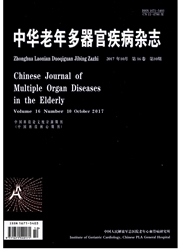

 中文摘要:
中文摘要:
目的:本研究旨在探讨激活乙醛脱氢酶2(ALDH2)对老龄小鼠缺血预处理(IPC)心肌保护作用的影响。通过观察成年和老龄小鼠心肌沉默信息调节因子相关酶1(SIRT1)活性在IPC过程中的差异,分析老龄鼠心肌IPC保护作用减退的可能机制。方法成年(2月龄)和老龄(20月龄)雄性C57小鼠(每组各6只)在体给予3个5min缺血/5min再灌注循环的IPC处理后,以冠状动脉左前降支结扎缺血30min再灌注4h建立在体小鼠急性心肌I/R模型。离体心脏行Langendorff灌流给予3个循环的5min停流/5min再灌注以模拟全心IPC,同时记录心功能变化。在体或离体再灌注结束后取心肌组织检测ALDH2和SIRT1活性,及蛋白质羰基化程度。结果与成年组相比,IPC处理并不能有效地改善衰老心肌的I/R损伤和SIRT1活性。检测心肌ALDH2活性显示,老龄鼠心肌ALDH2的活性较成年组显著降低并导致衰老心肌在I/R后出现羰基应激增强(均P<0.05)。IPC并不能有效改善老龄鼠心肌ALDH2活性和羰基应激程度。预先激活老龄鼠心肌的ALDH2可显著抑制衰老心肌的羰基应激,改善IPC对老龄鼠I/R心肌SIRT1有激活作用(P<0.05),进而促进老龄鼠心肌I/R后收缩舒张功能的恢复。结论激活心肌ALDH2可显著改善老龄鼠心肌IPC的保护作用,其机制可能与抑制羰基应激引起的SIRT1失活有关。
 英文摘要:
英文摘要:
ObjectiveTodetermine the effect of aldehyde dehydrogenase2(ALDH2) activation on the cardioprotection of ischemic preconditioning (IPC) intheelderly mice, and analyze the possible mechanism on aging-related IPC cardioprotection declineby investigating thedifference of silent information regulatorrelatedenzyme 1 (SIRT1) activity during the IPC processbetween the adult and aged mice.Methods Male C57BL/6adult (2 months old) and aged (20 months old) mice(6 in each group)were subjected to IPC (left anterior descending coronary artery was occluded for 3×5min, interspersed with 5min of reperfusion) andfollowed by ischemia/reperfusion (I/R, 30minischemia/4hreperfusion) injury. Hearts from aged C57BL/6 mice were Langendorff-perfused and subjected toin vitro IPC and I/R injury for cardiac function recording. At the end of reperfusion, ALDH2 and SIRT1 activity and protein carbonylation in the myocardial tissuein vivoandin vitro were measured.Results Compared with the adult hearts, IPC treatment failed to decrease I/R injury nor increase SIRT1 activity in the aged myocardium (P〈0.05). A significant decrease in ALDH2 activity was observed in the aged hearts (P〈0.05), which then resulted in enhanced carbonyl stress in I/R aged hearts (P〈0.05). Also, IPC treatment failed to improve ALDH2 activity nor decrease carbonyl stress in the aged myocardium (P〈0.05). ALDH2Activation inhibited the carbonylation level and restored the IPC-induced SIRT1 activation in aged hearts (P〈0.05), whichfurtherpromoted the recovery of systolic and diastolic function after I/Rinjuryin aged hearts.ConclusionActivating myocardial ALDH2 significantly improves the cardioprotection of IPC in aged hearts, which might be due to SIRT1 inactivation inducedby suppressing carbonyl stress.
 同期刊论文项目
同期刊论文项目
 同项目期刊论文
同项目期刊论文
 期刊信息
期刊信息
